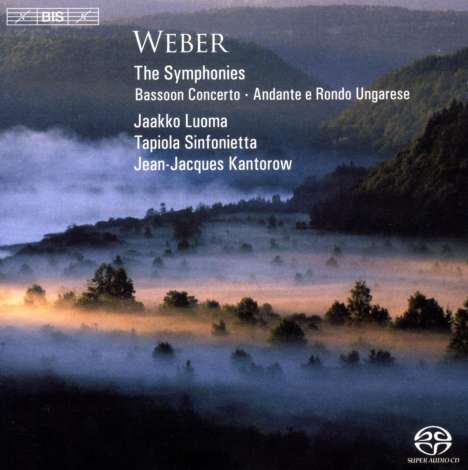Carl Maria von Weber: Symphonien Nr.1 & 2 auf Super Audio CD
Symphonien Nr.1 & 2
Die SACD verwendet eine höhere digitale Auflösung als die Audio-CD und bietet außerdem die Möglichkeit, Mehrkanalton (Raumklang) zu speichern. Um die Musik in High-End-Qualität genießen zu können, wird ein spezieller SACD-Player benötigt. Dank Hybrid-Funktion sind die meisten in unserem Shop mit "SACD" gekennzeichneten Produkte auch auf herkömmlichen CD-Playern abspielbar. Dann allerdings unterscheidet sich der Sound nicht von einer normalen CD. Bei Abweichungen weisen wir gesondert darauf hin (Non-Hybrid).
+Andante & Rondo Ungarese für Fagott & Orchester; Fagottkonzert
- Tonformat:
- stereo & multichannel (Hybrid)
- Künstler:
- Jaakko Luoma, Tapiola Sinfonietta, Jean-Jacques Kantorow
- Label:
- BIS
- Aufnahmejahr ca.:
- 2008
- Artikelnummer:
- 8587561
- UPC/EAN:
- 7318599916200
- Erscheinungstermin:
- 19.5.2009
The Tapiola Sinfonietta has recorded a number of highly acclaimed discs for BIS spanning a repertoire from Rautavaara, Pärt and Shostakovich to Saint-Saëns and Mozart. On one of the orchestra’s most recent releases, under conductor Jean-Jacques Kantorow, the programme was centred on the clarinet concertos by Carl Maria von Weber, with Martin Fröst as soloist. The orchestra’s contribution to the much-praised result was noticed by the reviewers, as witness the following description on website classicstoday. com: ‘perfect accompaniments: swift, sensitive, texturally transparent, and rhythmically snappy’. On the present disc Tapiola Sinfonietta and Kantorow revisit Weber, again focussing on works by the young composer, from before the fame that Der Freischütz would bring. The two symphonies – the only works in the genre that Weber composed – were written in the space of six weeks around New Year 1808, while Weber were staying at the court of the Count of Württemberg-Öls in Carlsruhe (nowadays Pokój in Poland). Their scoring reflects the forces available in the Count’s orchestra: apart from strings and timpani Weber could call upon a flute, two oboes, two bassoons, two horns and two trumpets. We may assume that the wind players were of exceptional quality, as these works offer them plenty of opportunities to show off. The symphonies also bear witness to the period of transition from classicism to romanticism, particularly in terms of orchestral colour. The two works for bassoon and orchestra included on the disc were composed a few years later, specifically for Georg Friedrich Brandt, bassoonist in the Munich Court Orchestra. They are here performed by Jaakko Luoma, the principal bassonist of the Tapiola Sinfonietta, who gives them their full measure of both flamboyant virtuosity and lyric songfulness.
Rezensionen
FonoForum 10/09: "Es ist nicht nur die flotte Zunge des Finnen, die einen so verzückt vor der Stereoanlage ausharren lässt, sondern das unendlich organische Ineinandergreifen der Solostimme und des von Jean-Jacques Kantorow geführten Orchesters. Das wird ausnahmsweise nicht - wie in Webers Konzerten nur allzu oft - zur bloßen Nebensache degradiert, sondern operiert auf Augenhöhe mit dem Solisten. Die Tapiola Sinfonietta präsentiert hier mit koboldhaften Holzbläsern und feurigen Streichern einen federnden, duftig-leichten Weber."Disk 1 von 1 (SACD)
Sinfonie Nr. 2 C-Dur
-
1 1. Allegro
-
2 2. Adagio, ma non troppo
-
3 3. Menuetto-Trio: Allegro
-
4 4. Finale (Scherzo): Presto
Andante e Rondo ungarese op. 35 (für Fagott und Orchester)
-
5 1. Andante
-
6 2. Allegro ungarese
Konzert für Fagott und Orchester F-Dur
-
7 1. Allegro ma non troppo
-
8 2. Adagio
-
9 3. Rondo: Allegro
Sinfonie Nr. 1 C-Dur
-
10 1. Allegro con fuoco
-
11 2. Andante
-
12 3. Scherzo-Trio: Presto
-
13 4. Finale: Presto
Mehr von Carl Maria von ...
-
Carl Maria von WeberSämtliche OuvertürenCDVorheriger Preis EUR 17,99, reduziert um 0%Aktueller Preis: EUR 7,99
-
Carl Maria von WeberSilvana2 CDsVorheriger Preis EUR 29,99, reduziert um 0%Aktueller Preis: EUR 14,99
-
Dag Jensen - The Virtuoso BassoonCDVorheriger Preis EUR 17,99, reduziert um 0%Aktueller Preis: EUR 7,99
-
Carl Maria von WeberDer Freischütz2 Super Audio CDsAktueller Preis: EUR 7,99








